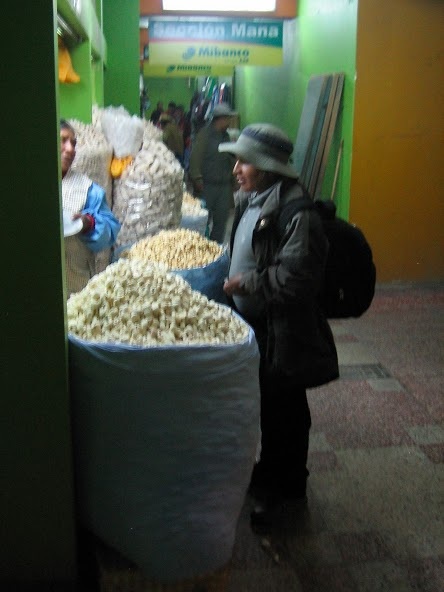We took a bus to Puno, Peru which is the largest city on the Peruvian side of Lake Titicaca. Like Juliaca, Puno is not an attractive town, but its saving grace is the lake. We stayed about 15 minutes outside of town. The area had a nice view of the lake, was much quieter and less polluted.
Lake Titicaca is the highest navigable lake in the world at 12,500 feet above sea level. I've never been this high above sea level so I was having a really hard time adjusting to the altitude. Chris felt fine but I suffered from a headache, shortness of breath and lack of energy for about a half day. We later discovered that 1 in 4 people suffer from altitude sickness and based on what I read, I had a pretty mild case. The people native to the Andes generally don't suffer because they are built a little differently. They have really large lungs, especially in relation to their bodies, so they can take in more oxygen than the rest of us.
They also drink mate de coca, or a tea made of coca leaves, which helps alleviate symptoms of altitude sickness. I tried the tea but only drank a few sips, as I did not enjoy the earthy taste. In addition to the headache and shortness of breath, the high altitude made me really sleepy. I napped during the day and fell asleep by 8pm in the evening. This worked out well since we had to be up really early in the morning to catch a boat out on the lake (more on this later).
Puno had interesting menu options including:
Frog Juice - This was by far the grossest food I've seen in Peru. The customer selects 2-3 frogs from an aquarium and they are thrown into a blender alive with a bunch of other ingredients. It's called Jugo de Rana and it's very popular with the locals. They say it gives you energy.
Guinea Pig - There were 3 cages of cute guinea pigs outside of our hotel. I thought to myself - How cute! They have little pets. Not so much. People in the Andes love to eat guinea pig. You often see signs outside of restaurants with pictures of guinea pigs roasted on a spit. Sometimes the signs even feature a nice picture of a live guinea pig smiling at you. They call the dish Cuy.
Alpaca - The alpaca is not just used for their wool, but also for their meat. A popular appetizer here is Alpaca carpaccio. It is supposedly very healthy relative to other red meats.
Quinoa - It's in everything. They eat it with milk for breakfast, in a soup for lunch (really good!) and we even had shrimp encrusted in Quinoa for dinner.
Potatoes - They have every kind of potato imaginable here. They say that the cultivated potato originated in the Andes mountains several thousand years BC. When the Spanish conquered the region, they brought potatoes back to Europe and introduced them to the rest of the world.
Tons of Chicharones (fried Pig Skins) - We went to the central market to see what kind of food they sold. There was an entire sections dedicated to Chicharones. 5 foot BAGS full of them.
Hey Mrs. Barbier's Class 2A! We have two questions for you: 1) What do you think Titicaca means? Hint: look at the shape of the lake here. Does it resemble an animal? 2)Would you try frog juice?





 RSS Feed
RSS Feed
